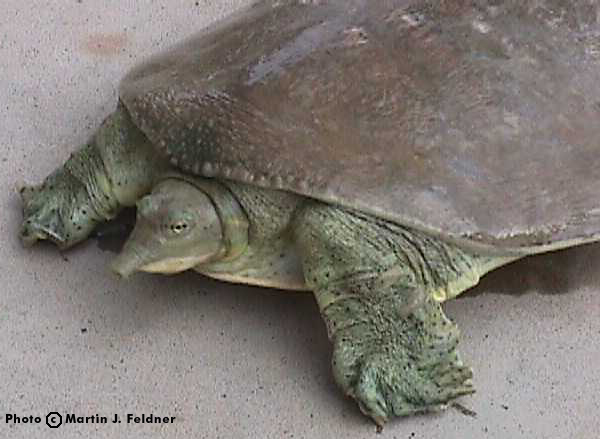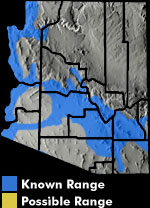Online Field Guide to The Reptiles and Amphibians of Arizona



Maricopa County, AZ
| SPINY SOFTSHELL Apalone spinifera | |
|
DESCRIPTION: A large (shell up to 470 mm or 18.5″ in length), exceptionally flat, disc-shaped water turtle with a leathery shell and a pointed, snorkel-like snout. Soft, fleshy lips conceal a large, sharp jaw. The leading edge of the shell is adorned with small tubercles. Overall coloration is tan, gray, or olive and the top part of the shell (carapace) is often marked with spots or ocelli. A thin, dark line runs around the margin of the light-edged carapace. Shell markings are more distinct on juveniles and males. The head and limbs are often marked with small, black flecks or speckles. The bottom part of the shell (plastron) is cream or white and is partially translucent. The limbs are flat and paddle-like and the feet are webbed. Females grow to a much larger size than males. Males have a sand-paper like texture on the carapace. DISTRIBUTION: Native to the eastern United States, this turtle has been introduced to permanent waters in southern and western Arizona. HABITAT: Occurs in rivers, canals, urban lakes, ponds, reservoirs, and irrigation ditches within Arizona’s desertscrubs and Semidesert Grassland communities. Seems to prefer relatively quiet, shallow waters with gradual banks and soft soil. BEHAVIOR: A highly aquatic turtle that rarely travels overland. It basks on the bank, on floating logs, or by floating in sunlit surface water. It also thermoregulates by burying itself in the soil beneath shallow, sun-warmed water and using its long neck and snorkel-like snout to reach the surface for air. It is able to extract oxygen from the water through the blood vessel rich linings of its pharynx and cloaca. This enables the turtle to stay underwater for long periods of time. It is capable of striking quickly and can deliver a painful bite. REPRODUCTION: Mates in April and May. Buries a clutch of up to 39 brittle-shelled eggs in a shallow nest on the bank in summer. By Thomas C. Brennan Brennan, T. C., and A. T. Holycross. 2006. A Field Guide to Amphibians and Reptiles in Arizona. Arizona Game and Fish Department. Phoenix, AZ Brennan, T. C., and A. T. Holycross. 2005. A Field Guide to Amphibians and Reptiles of Maricopa County. Arizona Game and Fish Department. Phoenix, AZ Degenhardt, W. G., Painter, C. W., and Price, A. H.. 1996. Amphibians and Reptiles of New Mexico. University of New Mexico Press. Albuquerque. Stebbins, R.C. 1951. Amphibians of Western North America. University of California Press, Berkeley, CA. Stebbins. 1985. Western Reptiles and Amphibians. Houghton Mifflin. New York, NY Stebbins, R.C. 2003. A Field Guide to Western Reptiles and Amphibians, Third Edition. Houghton Mifflin Company, Boston, MA. |
|
Visit Partners in Amphibian and Reptile Conservation:


HOME
Copyright © 2023, Arizona Game and Fish Department. All rights reserved.
If you make use of the textual contents of this site in reports, publications, etc. please cite and credit the author(s) and photographer(s). All photos on this website are copyrighted. However, those found in the species account section may be used for any noncommercial scientific, educational, or conservation purposes provided that photographs are not altered and continue to bear the copyright symbol and name of the photographer. Please contact the photographer regarding commercial use of copyrighted photographs.










